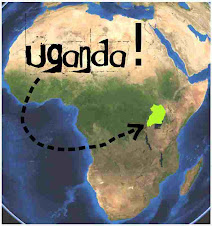The three stone fire is an essential component of Ugandan cooking, and is as ingrained in local culture as the languages Ugandans speak. The set-up is simple: a wood fire, three stones placed around the fire, and a pot resting on top of the stones, filled with simmering meat stew, rice, or matooke bananas. This (or a similar variation) is how the majority of Ugandans prepare their food. The formula hasn't changed much since humanity first learned to harness the power of flame.
Unfortunately, this simple way of cooking has some serious drawbacks. First of all, the smoke given off by a three stone fire is a major cause of respiratory illness. Many Ugandan homes have a separate hut for cooking so that the smoke doesn't enter the house itself, but that doesn't do much for the cook, who must tend to the food and the fire for hours on end (Uganda has America beat on the slow food movement by a good 12 centuries or so). Secondly, the combustion reactions that happen in a wood fire release tremendous amounts of carbon dioxide, which contributes to global warming. Finally, a three stone fire wastes wood: the large gaps between the stones expose the burning wood to lots of air, allowing heat to escape without cooking the food, and causing the wood to burn up quickly. Wasting wood here is no laughing matter; Uganda is currently suffering from severe deforestation, to the extent that it may need to begin importing wood from neighboring Kenya, a costly move. Many Ugandans have planted eucalyptus trees, which reach maturity in just four years, to combat deforestation, but this is not without its own pitfalls. Eucalyptus is not native to Africa; it was introduced to the continent from Australia in the late 18th century on one of Captain Cook's round-the-world voyages. In African soil, the tree is a notorious water hog, drainining so much moisture from the ground so that nothing but short grass can grow nearby. Not good in a place where upwards of 80% of the population are farmers.
Enter the "rocket stove". The rocket stove is a marvelous device made of locally available materials, including bricks, clay, mud, sawdust, and rice husks. It seals in the heat of a wood fire, directing most of the energy towards the cooking pot with minimal losses. It creates a nearly smokeless fire. It uses 60% less wood than a three stone fire. And a twin burner industrial size model (ideal for schools) costs less than $200 to make.
 |
| PCV Heather shows us how it's done. |
 |
| The rocket stove is scientifically designed to make the world more awesome. |
This past weekend I made the six-hour trek up to Gulu, a large town in northern Uganda, to help Drew and Bina, two married Volunteers, build some rocket stoves at their site. The event was the first of a series that I'll be attending this year as part of Peace Corps' 50th anniversary celebration. Upcoming events include rehabilitating a primary school south of Kampala next weekend, and painting informational HIV/AIDS murals at my friend Ashley's site in Rakai District, near the Tanzanian border.
I liked Gulu a lot. It's a much larger and nicer town than Hoima, which is probably attributable to the development work done by the gazillions of NGOs that call it home. Northern Uganda receives a lot of foreign aid because of the rebel warfare that ravaged its countryside for twenty years, forcing millions of people into internally displaced persons (IDP) camps and annihilating any kind of economic activity. The NGOs that flock to set up shop in Gulu bring in foreign workers (read: young, idealistic upper middle-class white folks), which encourages locals, and some of the foreigners, to create businesses that cater to them. Needless to say, I spent a lot of the long weekend indulging in all things mzungu: chatting in trendy coffee shops, eating hamburgers, Indian, and Ethiopian food, and floating on my back in the pool of an upscale hotel.
But somewhere between eating good food and partying with NGO workers, we managed to get two rocket stoves built for Drew and Bina's host organization, the Gulu Youth Development Association (GYDA), which provides classes and vocational training to youth unable to go to secondary school for behavioral or other reasons. The turnout was fantastic. We had way more than enough help, which was great because it meant that the PCVs could take a step back and let the locals learn how to make the stoves themselves.
 |
| PCV Jill oversees the bricklaying operation. |
Still, we enjoyed getting our hands and feet dirty:
I had to get back to site early in order to teach, so I left before the stoves were finished, but all in all it was a fun, productive weekend.
And now, some cute Acholi kids:














No comments:
Post a Comment